-
Car Reviews
- All reviews
- Midsize SUVs
- Small cars
- Utes
- Small SUVs
- Large SUVs
- Large cars
- Sports SUVs
- Sports cars
- Vans
Latest reviews
- Car News
-
Car Comparisons
Latest comparisons
- Chasing Deals
Unusually-styled electric sedan impresses with a full set of impressive dynamics, from quiet motors to a properly resolved suspension
A few years ago, car company product planners were ready to sign the death warrant of the traditional sedan – a form factor that drivers were abandoning in droves.
It’s taken the rise of the EV to make buyers see the clear benefits of a slippery and low shape – the kind of thing SUVs just can’t pull off.
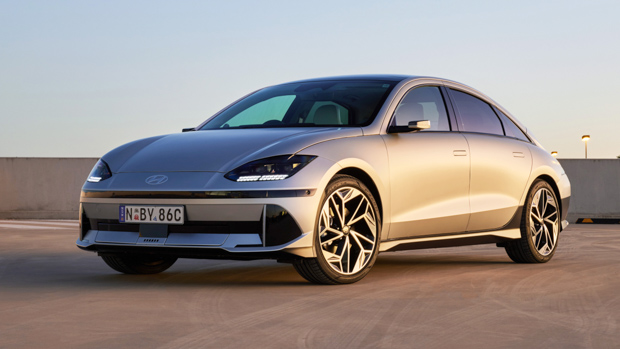
The benefits of traditional sedans are made indelibly clear in the 2023 Hyundai Ioniq 6 EV.
This new electric car is the near-mechanical twin of the brand’s Ioniq 5 SUV that was released in 2021 – but by swapping that model’s boxy and high-set shape for saloon slickness, you get a 20 percent maximum range improvement.
There’s been no change to the battery and no relevant alteration to any of the motors and mechanicals: it is simply that when it comes to EVs, where aerodynamic drag can make or break a car’s energy efficiency, the SUV-to-sedan conversion nets 20 percent economy improvements.
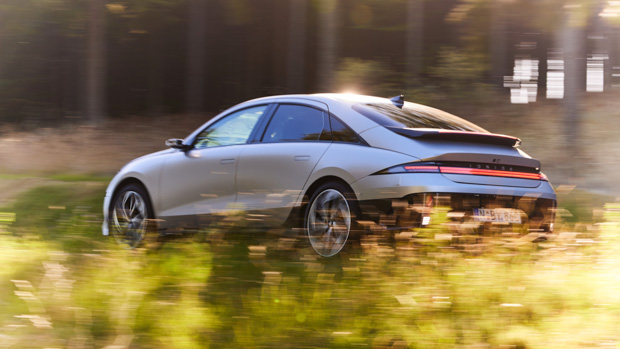
Car fans and driving enthusiasts, who have clung to sports cars, sedans and station wagons as effectively left-field alternatives to common SUVs, might now be joined by a new cohort of everyday Australians keen to simply drive their dollar further.
If that’s the case, that’s wonderful. But while the Ioniq 6 electric car delivers a solid range and efficiency bump over its well-rated Ioniq 5 relation, to concentrate on economy would be to miss the point of this car: the Hyundai Ioniq 6 is a terrifically well-executed EV, and certainly one of the best EVs with pricing under $100,000.
Australians have found it very difficult to buy one of Hyundai’s premium-grade Ioniq electric vehicles over the last couple of years, with tight global supply being directed mainly to Europe, because of that continent’s severe emissions tax regime.
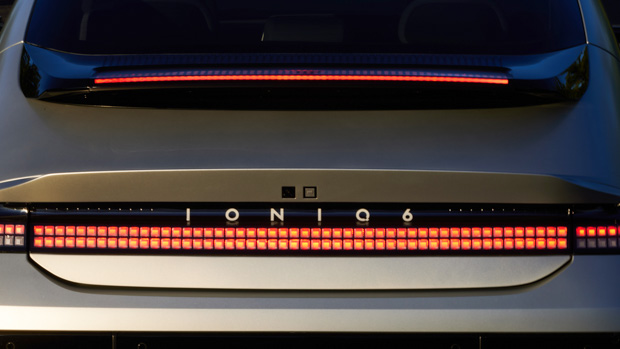
But production of the Ioniq models is now gearing up and Hyundai expects to deliver about 3000 Ioniq 5 and Ioniq 6 examples in Australia in 2023, and 6000 in 2024.
So if you’re in the waiting list, hold on – because our first test of the 2023 Hyundai Ioniq 6 sedan, conducted on challenging but fun driving roads in the east coast riverina revealed that this car has deeply impressive dynamics.
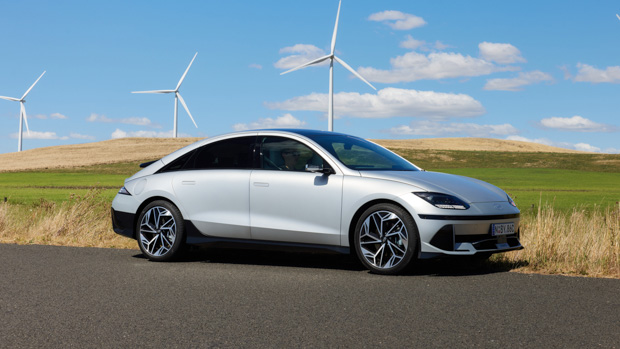
It also has very solid build quality and the undoubtable advantages of an 800-volt electrical architecture that enables highway recharging top-ups in less than 20 minutes – a feat that even the best-selling Tesla Model 3 and Tesla Model Y can’t match.
However, like most EVs, the Ioniq 6 is fairly expensive to buy. Is it worth $80,000-driveaway pricing or more – and do you need to splash for the top-end Epiq model?
Hyundai sells the Ioniq 6 electric car in three varieties in Australia.
The most affordable model is the still well-equipped Dynamiq RWD ($74,000 before on-road costs), before the range moves on to the more luxurious Techniq AWD ($83,500) and the flagship Epiq AWD ($88,000) that is being tested here.
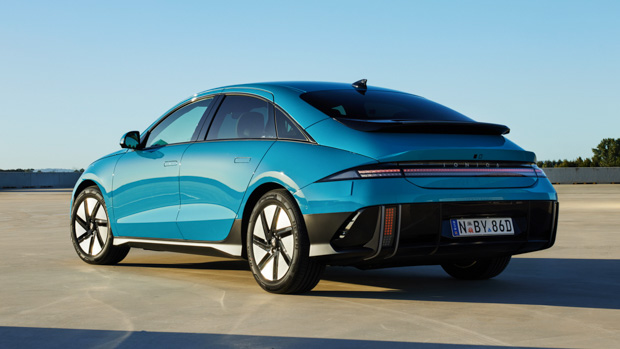
Pictured: the entry-level Ioniq 6 Dynamiq RWD
Standard on all Ioniq 6 models is the following equipment:
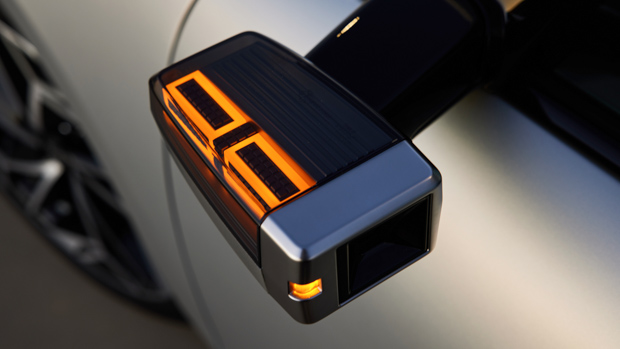
The middle-specification Ioniq 6 Techniq AWD adds the following equipment at a $9500 upcharge over the base Dynamiq model:
Finally, the ultimate Ioniq 6 model, the Epiq all wheel drive ($88,000), adds these extras:
Hyundai Australia is currently developing a build-to-order system for its Ioniq models that it says should allow Aussie customers to mix and match RWD/AWD, trim grades, exterior/interior colours and even a lighter short-range battery from the South Korea factory by 2024.
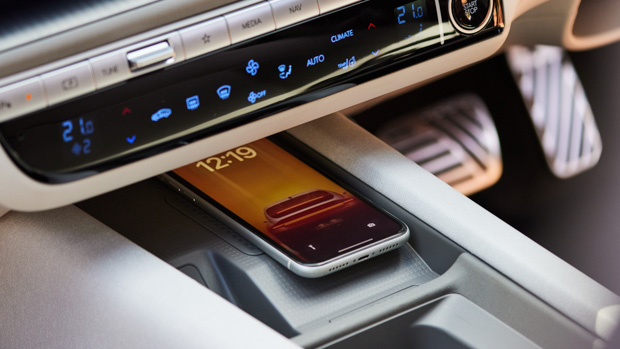
Notable omissions from the Ioniq 6 specification sheet include car-as-key functionality (allowing you to leave the new H-shaped keys at home).
Hyundai’s feud with a smartphone manufacturer also continues without relief, meaning that unlike most rivals, Apple CarPlay and Android Auto still require an (old-school) USB-A cable.
The best thing about the Hyundai Ioniq 6 EV is the way that it drives. Most electric cars that cost less than $100,000 have some significant issue with their driving behaviour – usually bad ride quality or ponderous, wayward handling.
In the case of the Tesla Model 3, the Ioniq 6’s most direct rival, it’s a brittle suspension tune that lacks finesse. Hyundai wanted to avoid this effect, and it succeeded with the Ioniq 6, which launches with a seriously polished suspension tune.
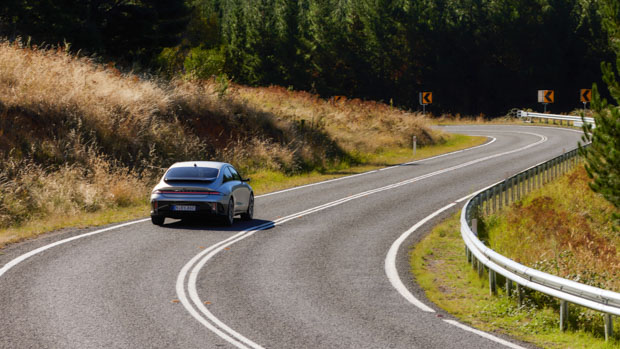
Australia has lifted to a European ride, handling and stability control tune for the Ioniq 6 – a process it contributed to by sending local engineers to prototype drives of this EV while it was being developed.
The Ioniq 6 may not have the fully-Australianised suspension and steering setup of Hyundais of old – but it simply doesn’t need one.
Demonstrating poise, control and supple damping on engaging but rough roads, the Ioniq 6 is more than a cut above a Model 3 in terms of polish.
We genuinely enjoyed our drive in two flavours of Ioniq 6 on difficult country roads around the town of Albury on the New South Wales–Victoria border.
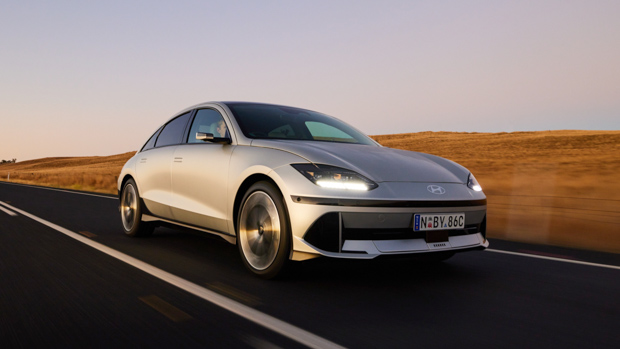
While the Dynamiq RWD with a single motor model offers superior ride comfort thanks to its smaller 18-inch wheels and cushier Nexen eco-tyres, the two all wheel drive models don’t give up much by way of cabin insulation even though they move to lower-profile Pirelli rubber and bigger 20-inch alloys.
As you’d expect, there is more road feel in the Techniq AWD and Epiq AWD models, but the bigger wheels don’t spoil the ride. Still, if your commute takes in a lot of broken-up concrete roads or unfilled potholes, go for the Dynamiq RWD.
In the ride quality and body control departments, the Ioniq 6 is an outstanding midsize car – let alone one of the best EVs under $100K.
It’s even remarkably agile, with zealous turn-in from the front wheels, tenacious grip (especially on the Pirellis) and an adjustable chassis that provides keen drivers with options.
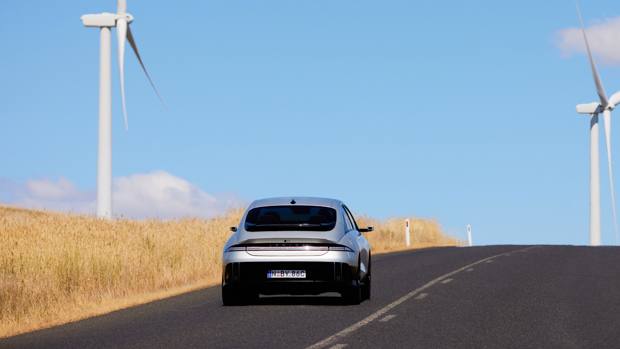
You can run a tidy and trim line in the Ioniq 6 and you’ll find the 239kW/605Nm AWD models to be serene and swift grand-tourers, but all Ioniq 6 grades are happy to be driven much more sportily.
The purist’s spec is the Dynamiq RWD model, which uses its 168kW/350Nm single rear motor to great effect, but the all wheel drive models don’t blunt the fun.
All of this bodes well for the future Ioniq 6 N model, which will be foreshadowed by the SUV-profile Ioniq 5 N that will be released in Australia in late 2023.
Speaking of performance, the all wheel drive cars are claimed to be able to complete a 0-100km/h time of 5.1 seconds. We’ll test this claim, as well as emergency braking distances, soon.
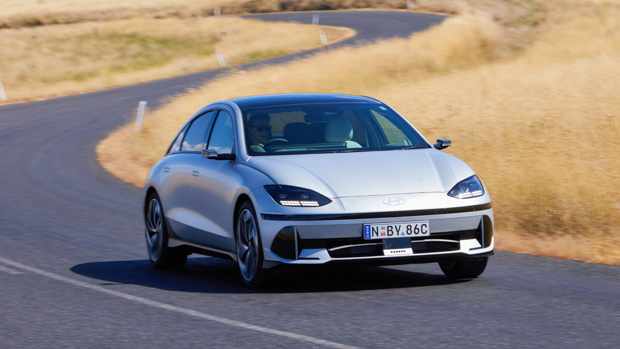
Impressively, Hyundai adds acoustic lamination to all the glass of this EV other than the rear window, and the result is a really hushed cabin even at 100km/h and beyond. Wind noise and tyre noise are minimal.
Brake pedal feel avoids the wooden nature of some other EVs. There are steering wheel paddles that change the regenerative braking force, with the most aggressive I-Pedal mode almost allowing full one pedal driving – sometimes you have to tap the brakes at traffic lights to come to a complete stop.
The combination of swift, refined motor performance, a supple ride, composed body and cabin quietness makes this a genuinely refined and serene car.
Arriving two years after the groundbreaking Hyundai Ioniq 5 model, the new Ioniq 6 four door sedan borrows much of its SUV sibling’s interior but extends it with cosmopolitan trim choices and new technologies.
Based around twin 12.3-inch displays that it shares with the Ioniq 5, as well as the Kia EV6 and Genesis GV60, the Ioniq 6’s interior feels technologically-savvy but not too overwhelming. But this car certainly isn’t nearly as minimal as the Tesla Model 3.
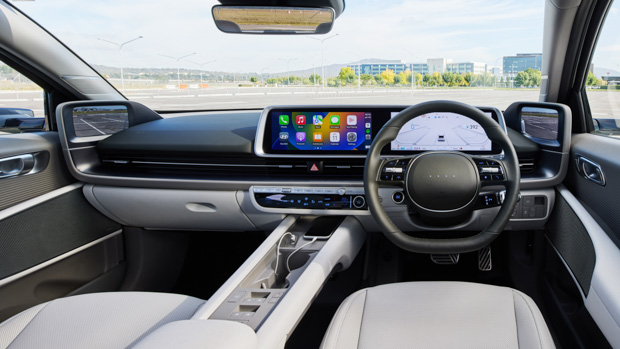
There are still dedicated shortcut controls for nearly everything, from the (real) volume knob to the soft-touch buttons for the climate functions – except for the seat coolers and heaters, which we prefer to use over blasting air-con most of the time.
Hyundai is just about to introduce a revamped operating system on its new Kona small SUV range, but the new software didn’t make the cut for the Ioniq 6 – and that’s a shame.
The Hyundai-Kia touchscreen system feels dated now, and some of the menu structures are a little arcane – and the driver’s display, which can show only a trip computer, next navigation direction or some basic settings, feels underdone at this price.
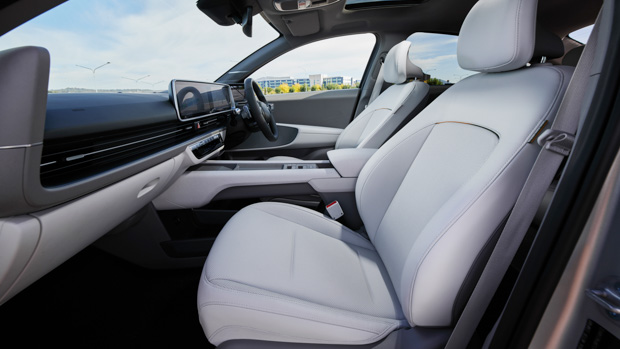
But the cabin’s layout is pretty intuitive, and the leather-wrapped steering wheel falls right to hand – as do controls for the window switches. These are locatetd on a tall central bridge of the interior that frees up bottle space in the doors and lets you balance a laptop mid-cabin while recharging.
Like the wheel, the seats are leather on all Ioniq 6 models. An animal-free interior isn’t yet possible, though Hyundai has an option to bring a cloth-seat option to Australia in future.
The front seats themselves are fairly comfortable, if a little lacking in the last inch or two of under-thigh support on longer drives.
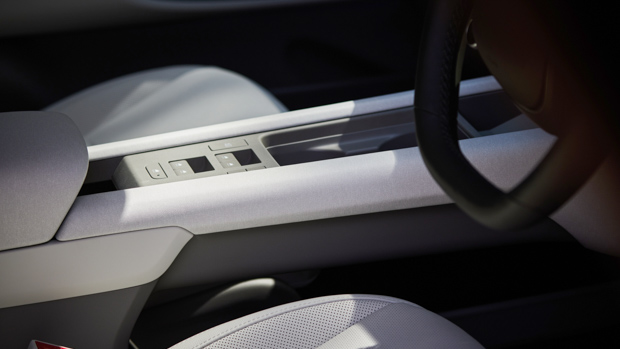
In the Techniq and Epiq AWD models, the driver’s seat and front passenger chair be reclined almost to a horizontal position to allow you to nap while charging, perhaps while also tapping into the Ioniq 6 cabin’s 3.6kW vehicle-to-load power point. Another is available outside the car.
Moving to the rear seats yields a common problem to electric sedans. Because the floor sits above the skateboard-like battery pack, headroom is compromised. However, the seat base is angled well to support the legs.
Six-foot adults will feel their head brushing the headliner because rear seat headroom is tight and the sloping roofline causes a compromise, but those of reduced stature will be comfortable with rear air vents and a flip-down armrest.
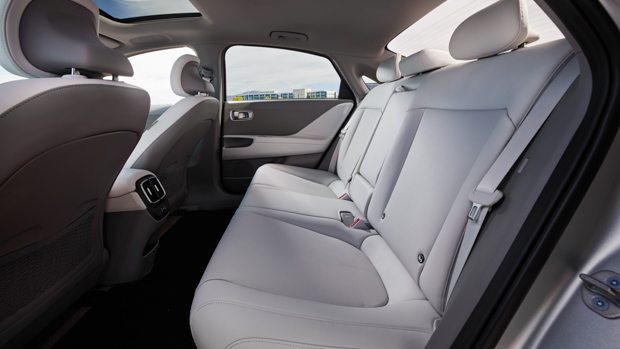
Compared to the flexible Ioniq 5 model, which is shaped like a large hatchback/midsize SUV crossover, the Ioniq 6’s traditional sedan shape means compromises to the boot space.
The tailgate is power operated on all models but it opens to reveal a narrow aperture, just 401 litres of cargo space, and no spare wheel at all – only a tyre mobility kit is available on this EV, like most rivals. However, you do get pull tabs to drop the rear seats.
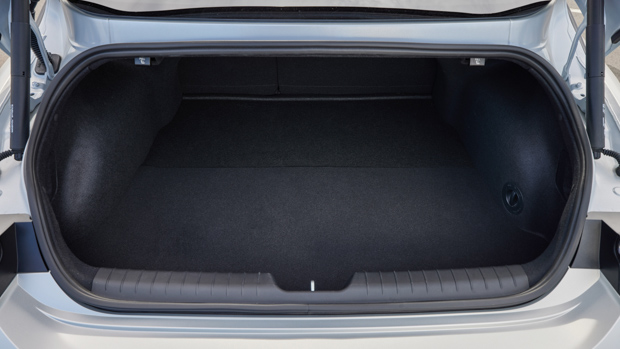
Hyundai should be congratulated for finding some room for a frunk / froot / front boot for the Ioniq 6, but it is laughably small compared to Tesla’s expertly-packaged Model 3 sedan.
That car has an 88-litre frunk, but the Ioniq 6 manages just 14.5L of space in AWD guise, or 45 litres in RWD format.
And unlike the Tesla, which covers the under-bonnet components with beauty covers, the Ioniq 6’s front storage box is awkwardly located among many fully-visible components, which looks interesting – but considerably messier.
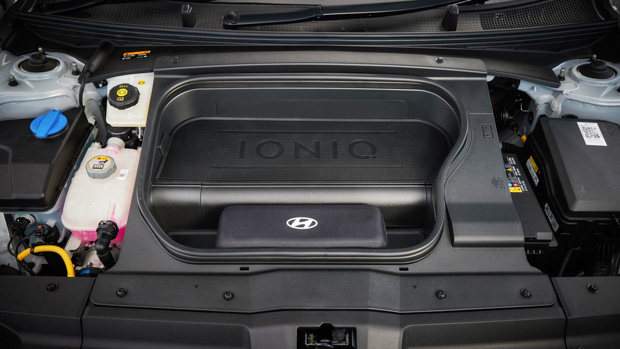
The Ioniq 6 sedan has not yet specifically tested by Australian car safety ratings organisation ANCAP, but it has already been crash tested by Euro NCAP.
In its crash test, the Ioniq 6 received a five-star result from Euro NCAP against 2022 testing criteria. Its scores were as follows:
ANCAP received this result from Euro NCAP and translated it to an Australian five-star safety rating for the Ioniq 6.
Much of the Ioniq 6’s semi-autonomous safety equipment has been calibrated to meet European regulatory requirements, without modification for Australian tastes.
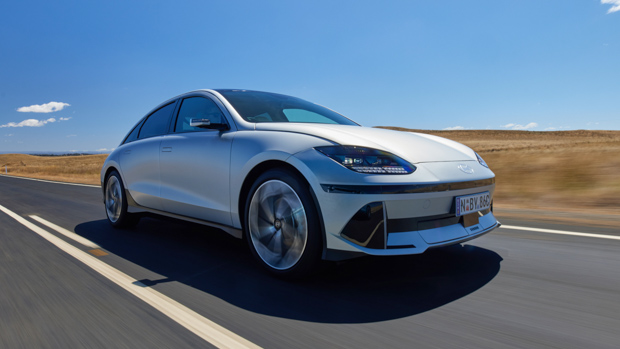
This includes an inappropriately strict speed limit warning system, which makes an incessant warning sound whenever you travel over any speed limit detected by on-board cameras – even if is no longer the correct speed limit.
Say you turn out of a 10km/h-signposted carpark onto an 80km/h road? You’re going to face that warning noise until the car next sees an 80-sign. It’s frustrating and poorly executed – and you have to turn in off every time to restart the car.
Thankfully, the Ioniq 6’s lane-centring assistance is among the best in the industry, relieving fatigue on longer road trips.
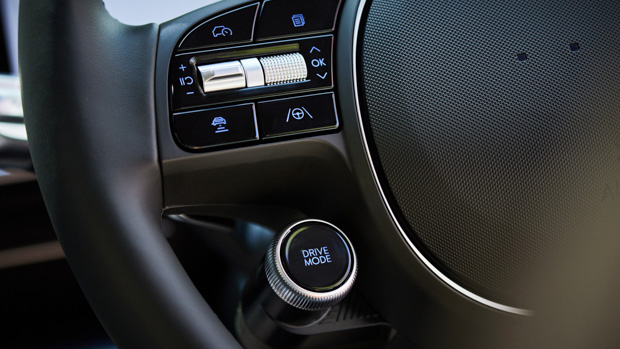
Further, all models are fitted with Hyundai’s blind-spot camera system which makes identifying objects to the side of the vehicle a doddle. We really like it.
The Epiq AWD grade is exclusively fitted with digital side mirrors with their own live displays located on buttresses at the ends of the dashboard.
All Ioniq 6 models have AEB with junction assistance and reversing AEB for parking collision avoidance.
These probably aren’t really necessary – conventional mirrors work fine – but Hyundai has tuned the resolution and viewpoint of the digital mirrors much more deftly than similar tech tested on the Audi E-tron SUV.
Thanks to its slippery and low-slung sedan shape, Hyundai makes bold claims about the frugality of the Ioniq 6. It should consume about 20 percent fewer electrons for every kilometre it travels than the Ioniq 5 SUV model.
We’re yet to conduct our Chasing Cars highway range and recharging test on the Ioniq 6 – this will happen soon.
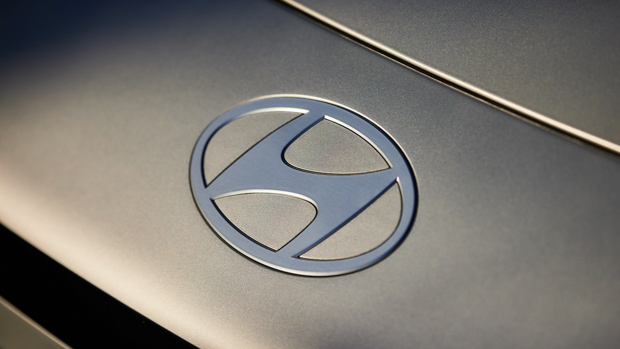
Our initial drive of the Ioniq 6 Epiq AWD model was heavily skewed to country routes at 100km/h with undulating terrain, with occasional rainfall – all conditions that drive up an EV’s consumption. Not easy stuff.
That is probably why we experienced a notable blowout from the Ioniq 6’s claimed WLTP energy efficiency of 12.7–14.3kWh/100km. Instead, we got 21.3kWh/100km.
On our loop, that can be inferred to be a range of 347 kilometres. We think this consumption will settle down considerably on the highway, and around town. We’ll report back soon.
Usefully, the Ioniq 6 uses the Hyundai e-GMP 800-volt EV architecture which can support ultra-rapid charging. On a compatible 350kW charger, the Ioniq 6 can be charged at peak rates of up to 233kW, which can restore 10-80% battery in 18 minutes.
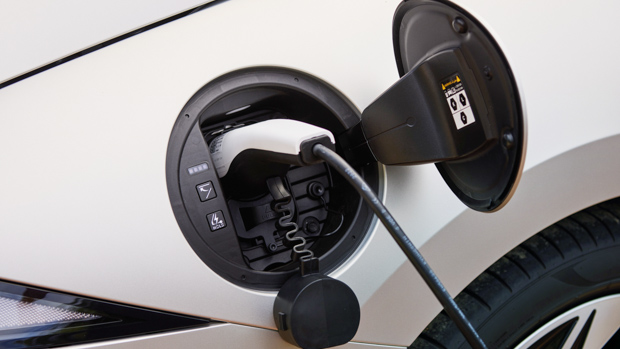
We tested this charging speed on the Epiq AWD that is the subject of this review. We plugged into a 350kW charger built by ABB and run by Chargefox outside Wodonga, Victoria.
Starting from around 40 percent state-of-charge, we immediately saw the vehicle shoot up to 225kW charging rates.
Hyundai recently amended the service intervals for its Ioniq 5 SUV and Ioniq 6 sedan EV models to a relaxed schedule of 2 years/30,000 km between scheduled maintenance.
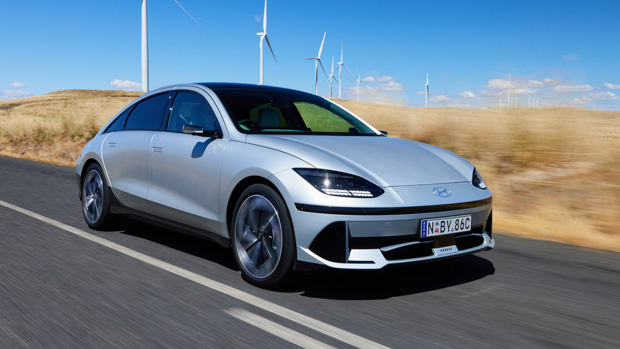
The first two services (at the 2 year and 4 year mark) cost $560 apiece for a four year/60,000 km servicing price of $1120.
A warranty of five years/unlimited km applies to most components on the Ioniq 6, but the high-voltage bits are covered by a separate warranty lasting for eight years or 160,000km.
Notably, the Kia EV6, which is closely related to the Ioniq 6, has a seven year/unlimited km warranty.
The Hyundai Ioniq 6 sedan joins a very limited club of EVs that we, as driving enthusiasts, can confidently say is genuinely impressive to drive.
Most EVs are functional enough and deliver an acceptable driving experience, but the more affordable ones under $100,000 usually labour with some kind of major deficiency. Normally bad ride quality or a boomy cabin. Or both.
Not so the tightly-built, quietly-insulated and supple-riding Hyundai Ioniq 6. This is an all electric sedan that delivers grippy handling and comfortable, rapid progress. Given the major challenges of making a heavy EV ride in an even and controlled manner, that’s an achievement in itself.
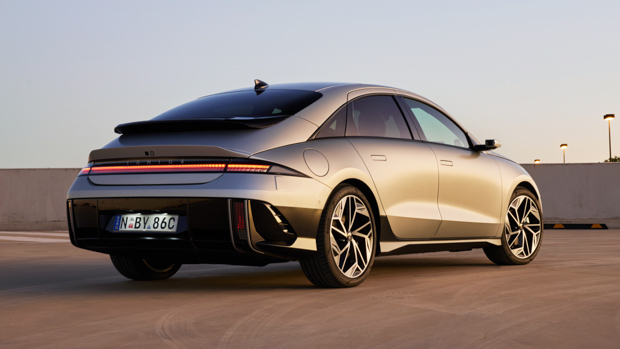
We’re very keen to see what the highway range of this vehicle is really like. After all, Hyundai has written some fairly heavy cheques around 500-600km rated range. Can the Ioniq 6 deliver? We’ll soon report on whether it can.
But when it comes to touring on classic Australian B-roads, few EV sedans do it as well as the Ioniq 6. To better this at the time of writing in March 2023, you’d be looking at the BMW i4 (from $99,900), or the Porsche Taycan (from $158,100). And that is no shabby set to be aligned with.
Key specs (as tested)
About Chasing cars
Chasing Cars reviews are 100% independent.
Because we are powered by Budget Direct Insurance, we don’t receive advertising or sales revenue from car manufacturers.
We’re truly independent – giving you Australia’s best car reviews.
The estimate provided does not take into account your personal circumstances but is intended to give a general indication of the cost of insurance, in order to obtain a complete quote, please visit www.budgetdirect.com.au. Estimate includes 15%^ online discount.
^Conditions Apply
Budget Direct Insurance arranged by Auto & General Services Pty Ltd ACN 003 617 909(AGS) AFSL 241 411, for and on behalf of the insurer, Auto & General Insurance Company Limited(ABN 42 111 586 353, AFSL 285 571).Because we don’t know your financial needs, we can’t advise you if this insurance will suit you. You should consider your needs and the Product Disclosure Statement before making a decision to buy insurance. Terms and conditions apply.
Indicative quote based on assumptions including postcode , 40 year old male with no offences, licence suspensions or claims in the last 5 years, a NCD Rating 1 and no younger drivers listed. White car, driven up to 10,000kms a year, unfinanced, with no modifications, factory options and/or non-standard accessories, private use only and garaged at night.
^Online Discounts Terms & Conditions
1. Discounts apply to the premium paid for a new Budget Direct Gold Comprehensive Car Insurance, Third Party Property Only or Third Party Property, Fire & Theft Insurance policy initiated online on or after 29 March 2017. Discounts do not apply to optional Roadside Assistance.
2. Discounts do not apply to any renewal offer of insurance.
3. Discounts only apply to the insurance portion of the premium. Discounts are applied before government charges, taxes, levies and fees, including instalment processing fees (as applicable). The full extent of discounts may therefore be impacted.
4. We reserve the right to change the offer without notice.